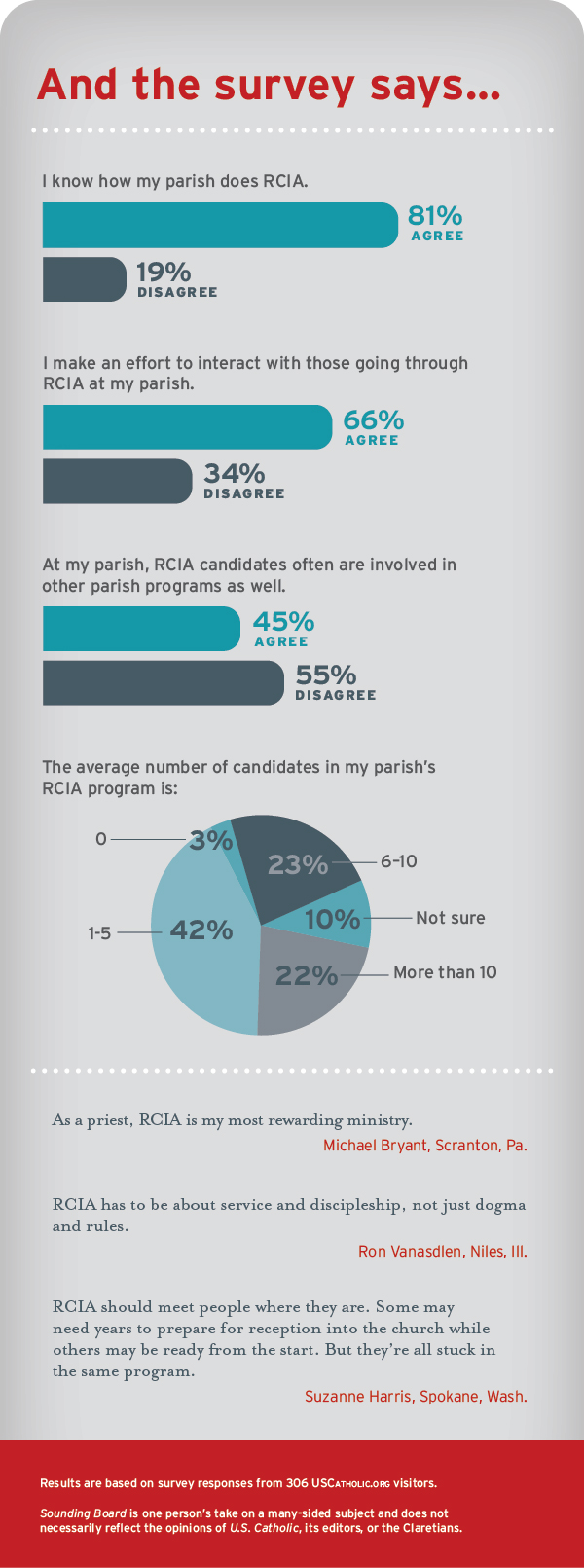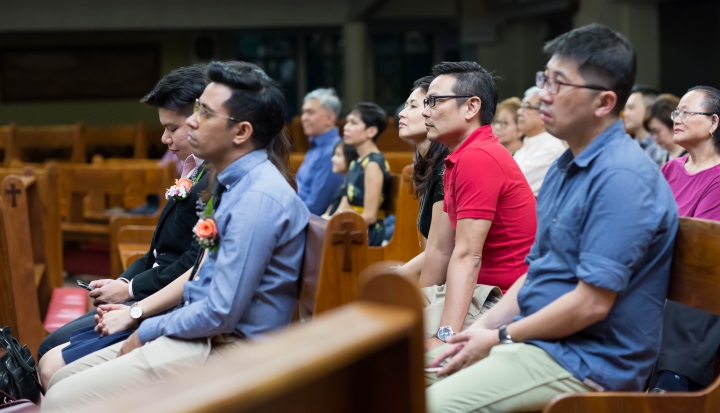When Rocio showed up at our parish, she knew nothing about the Catholic Church. All she knew was that her life was filled with darkness and she hungered for something more. It was January, and our RCIA sessions had begun months before. So our catechetical team asked Rocio to come to Mass each Sunday and hang out with the community. We hoped this would keep her interested until she could join the next RCIA in the fall and we could teach her about becoming a Catholic.
Rocio came to Mass every Sunday and sat with several people we had asked to keep her company. After Mass they would go out for coffee and answer her questions, basic things such as “Why do you put your hand in that water?” or “Where do you find all those readings in the Mass?” They introduced Rocio to their friends and other parishioners. Some of them invited her to their homes for dinner. Others told her about their Bible study group and made plans to bring her when she was available.
Some young adults close to Rocio’s age discovered they shared a love for cooking, and Rocio became a regular at their monthly cuisine nights. Rocio saw a bulletin announcement about the rosary and asked her new Catholic friends about it. They connected her with the parish rosary group and accompanied her to one of their gatherings. The group heard Rocio was coming and gave her a rosary of her own. They were so patient with her that day, teaching her how to pray this devotion they loved as she imitated their gestures and prayerful demeanor. When they saw her at Mass, they would always stop to chat with her.
That summer the parish was going to Tijuana for an annual service trip at an orphanage. Rocio’s new parish friends convinced her to go with them. She fell in love with the kids there, and her previous shyness gave way to an exuberant personality.
Meanwhile my RCIA team had been meeting every Wednesday night with that year’s catechumens, candidates, and their sponsors. We had our lessons neatly scheduled and our Powerpoints all planned. By the time Easter came we had covered all our topics, but our biggest challenge every year was keeping the newly initiated involved in the parish. No matter how much we encouraged them to be part of the community after Easter, they still lamented that they “couldn’t be part of RCIA anymore” or disappeared from the parish altogether.
While Rocio was serving at the orphanage, the RCIA team was planning our 26-session curriculum for the next round of RCIA candidates. We also had to find enough presenters and convince parishioners who could make the 26-week commitment to be sponsors. Most years we had to double- or triple-up and have catechumens share the same sponsor because we just couldn’t find enough people to say yes.
September came, and we were relieved that finally we could teach Rocio about becoming Catholic. She attended the first meeting with two of her friends from the parish and asked us if they could be her sponsors. We were pleasantly surprised and gladly agreed. They were excellent choices and model parishioners!
Rocio kept surprising us over the next several weeks with how much she already knew about the faith. She talked about reading the Bible each week and could reflect prayerfully on many of the gospel stories. One night she shared about how she prayed the rosary and her growing love for Mary. On the topic of the Eucharist, she immediately connected her young adult cooking group and those gatherings to the meals Jesus shared with his friends and the outcast. When the lesson on Catholic social teaching came around, she told us of her experience serving at the orphanage, and we were all deeply moved when she talked about seeing Christ in those children. It was Rocio who taught us that night the true meaning of the preferential option for the poor.
Our biggest surprise came at her rite of acceptance. She had an entire cheering section made up of people from the Bible study and rosary groups, the young adults, those who had gone to the orphanage, and other friends she had made in the parish. Their enthusiasm was infectious, and our assembly, typically annoyed by our RCIA rituals, seemed genuinely engaged in praying for Rocio as she made her first public commitment to follow Christ.
For the last 30 years, the Rite of Christian Initiation of Adults has been the way communities in the United States initiate adults and children. Yet I believe that in many parishes—at least in my parish with Rocio—what we have been doing is not actually RCIA.
RCIA is meant to help people like Rocio “seek the living God and enter the way of faith and conversion as the Holy Spirit opens their hearts,” resulting in baptism, confirmation, sharing in the Eucharist, and enabling them to “carry out the mission of the entire people of God in the church and in the world.” It is a “gradual process that takes place within the community of the faithful” in which the community renews their own conversion so as to “provide an example that will help the catechumens to obey the Holy Spirit more generously.”
If we look at how we do RCIA in most communities, however, its purpose seems to be teaching people about Catholicism rather than training them to live as disciples. Furthermore, the way we have done RCIA is primarily through Catholic doctrinal classes disconnected from the community instead of hands-on discipleship training within the community of the faithful, in the places and through the activities the faithful actually engage in as disciples.
Rocio taught me that we need to stop trying to get the parish involved in RCIA and start getting the catechumens and candidates involved in the parish because that is where they meet Christ active in the world. It is how both catechumens and parishioners deepen their conversion and become more credible Christian disciples.
Do we get rid of our RCIA sessions and just let our catechumens wander the wilds of parish life? No, but we need to remember that our sessions are secondary. They are meant to build upon what the catechumens learn by encountering Christ within the community. Our primary focus should be incorporating our catechumens into the life of Christ embodied in four areas of Christian life present in every parish: word, community, worship, and witness. Training in these areas together constitute the church’s methodology for making lifelong disciples.
If we use our entire parish life and its activities in the way we do RCIA, we will make lifelong disciples instead of name-only Catholics. We will introduce our catechumens to the living Christ found not in a lesson plan but in the people who bear Christ’s name. And we will help our parishioners live their baptism more fully and deepen their own conversion as they strive to be examples for those who seek Christ.
Eventually we were able to help Rocio become Catholic. But her presence and participation in the community helped us all become disciples.

This article also appears in the August 2018 issue of U.S. Catholic (Vol. 83, No. 8, pages 34–37).
Image: Flickr cc via Geoffrey Cheok















Add comment